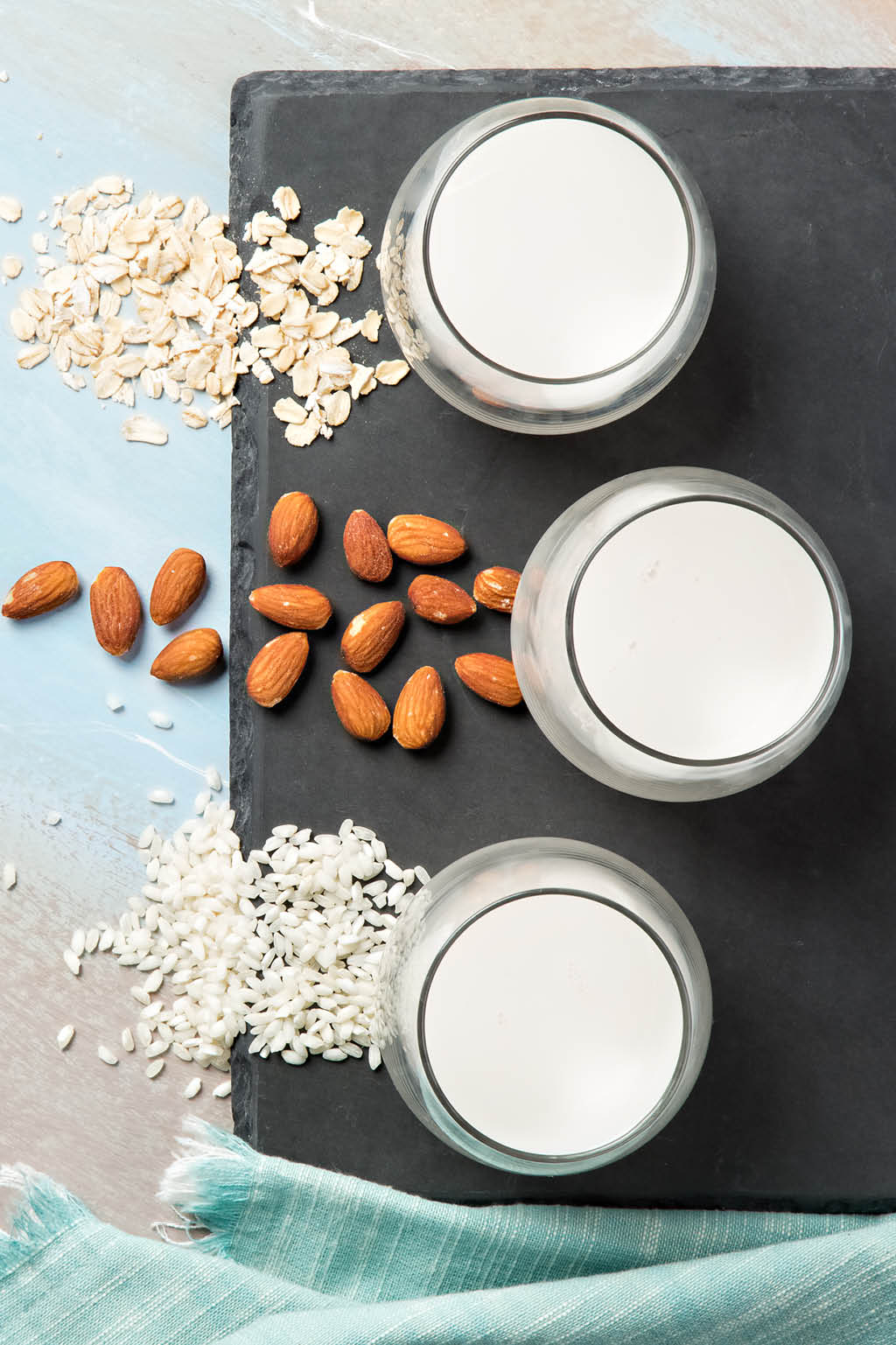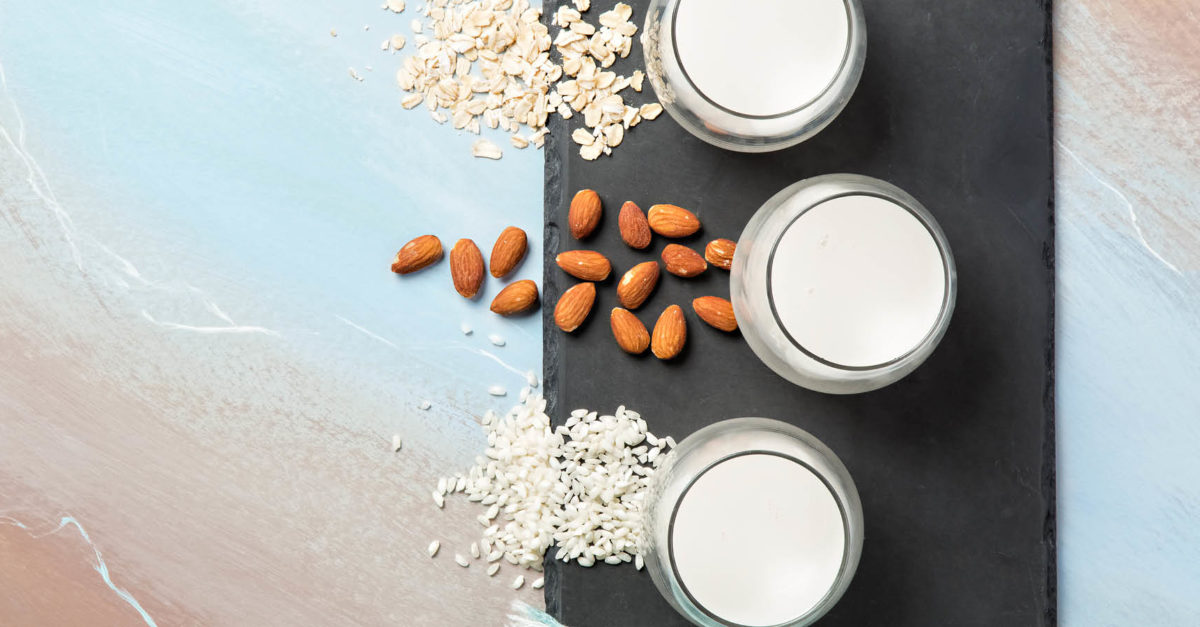Mad about Milk
In previous years, if you perused the daily aisle shopping for some milk, you really had but one option: cow’s milk.
Nowadays, what is labeled as milk on grocery store shelves varies pretty dramatically. Aisles are full of milk alternatives—from almond milk to soy milk—giving shoppers free rein over what type of milk they choose to pour over their morning cereal. When opting for a substitute for cow’s milk, it’s important to know that each alternative has its own unique nutritional profile, with benefits that vary in the amount of protein, fiber, fat, vitamins, and minerals.
One of the most common reasons for the switch? According to Food Allergy Research & Education
(FARE), more than 2 percent of children under the age of three suffer from a milk allergy, and though most outgrow this issue, it is still among the most common food allergies in adults. Like most other allergens, people have varying degrees of negative reactions to dairy milk, from an upset stomach to more serious complications such as hives and anaphylaxis.
“Financial Times reports that worldwide sales of nondairy milk alternatives more than doubled between 2009 and 2015,” cites Caroline West Passerrello, a registered dietitian nutritionist and spokesperson for the Academy of Nutrition and Dietetics. “Meanwhile, consumption of cow’s milk dropped 13 percent between 2014 and 2019.” And these trends have continued, with the dairy alternative industry leapfrogging while cow’s milk sales declined; a few cow’s milk producers even went out of business.
Some milk alternatives, like soy, come close to cow’s milk in nutritional value; others, such as coconut milk, can be high in fat and sugar content, though lower in calories. So before you make the switch from traditional milk, understand the positives and negatives associated with your new milk of choice, as you might need to make up for nutrients elsewhere in your diet.
Cow’s Milk
Calories: 110 | Protein: 8g
Fat: 2.5g | Carbohydrates: 12g
*Per 8-ounce glass of low-fat dairy milk
Though there are plenty of valid reasons to shy away from dairy milk—allergies, dietary restrictions, ethics, taste—when consumed in moderation, it is still a perfectly viable way to get a daily dose of important vitamins and nutrients our bodies need. A single serving of cow’s milk has 30 percent of the recommended daily allowance of calcium, 25 percent of the RDA of vitamin D, plus other essential nutrients like vitamin B12, potassium, and phosphorous. For decades, cow’s milk has been considered a dietary necessity, especially for children, in order to build strong bone health. West Passerrello notes that milk has nine essential nutrients, is a high-quality source of protein, and has no added sugars. While it does have significant levels of calcium and vitamin D—two key nutrients in bone density and strength—these can also be obtained from other milk alternatives, as well as a number of other foods like leafy greens and beans.
Soy Milk
Calories: 110 | Protein: 8g
Fat: 4.5g | Carbohydrates: 9g
*Per 8-ounce glass of unsweetened soy milk
As the first nondairy milk offered in grocery stores throughout the United States, soy milk has more than sixty years of USDA research behind it and is, by far, one of the most popular substitutions. Soy milk began to rise in popularity in America as a way for dairy-sensitive folks to be able to consume a similar product. Name brands such as Silk started popping up in the 1970s and eventually became more mainstream in the latter half of the century. One of the biggest benefits of soy milk is its similar nutrition density to dairy milk: it has just as much naturally occurring protein and caloric value. Depending on the type, soy milk can also be equal to or have less than the amount of fat found in traditional milk and fewer carbohydrates. If you do opt for this alternative, just be sure to look for a brand with the non-GMO-verified label.
Almond Milk
Calories: 60 | Protein: 1g
Fat: 2.5g | Carbohydrates: 8g
*Per 8-ounce glass of unsweetened almond milk
For some people, the taste of traditional dairy milk is one of the biggest deterrents. It’s not particularly sweet, and in a search for a better-tasting, vegan alternative, companies began producing nut milks like almond milk. Ground almonds and water are all it takes to create this slightly sweeter beverage, and, although it’s generally more flavorful than regular milk, it is also less calorie-dense because of its high water content. For people without nut allergies, almond and similar nut-based milks can be a great low-calorie replacement for dairy milk. However, it’s important to keep in mind that vitamins and nutrients are often added to these drinks because naturally occurring nutrients like protein and vitamins A, B, and D can be lost during production. When these values are added in it can be harder for the body to absorb them.

Oat Milk
Calories: 130 | Protein: 4g
Fat: 2.5g | Carbohydrates: 24g
*Per 8-ounce glass
Oat milk is one of the newest milk alternatives on the market, and it offers a healthy option for people allergic to both dairy and nut milks. However, oat milk is made from oats that are toasted and hulled and is often fortified with other ingredients such as seeds and beans, so it may still pose a problem for people with certain allergies; it’s important to read the label before purchasing. Because it is relatively new to the market, oat milk might be harder to find in stores than other milks, but it’s growing in recognition, especially at urban coffee shops and cafés. After it’s processed, oat milk has a waterier consistency, similar to that of skim milk, and tastes slightly sweeter than cow’s milk. Naturally occurring sugars in the oats raise the level of carbohydrates and calories in this alternative, but it has higher levels of protein and iron, too.
Rice Milk
Calories: 120 | Protein: 1g
Fat: 2.5g | Carbohydrates: 23g
*Per 8-ounce glass
Unfortunately for some people, most dairy milk alternatives still raise the risk of an allergic reaction, as soy, nuts, and wheat are among the most common food allergies. There is one alternative, however, that poses very little threat: rice milk. Made traditionally by soaking brown rice in water, rice milk has a higher starch content, which produces a sweet taste that many people might appreciate. This high starch content also gives rice milk more carbohydrates, but it remains relatively low in fat content, despite its higher level of calories and sugars. It offers very few nutrients compared to other alternatives, though, with less than a gram of protein per serving. Despite its lack of nutrients and vitamins, rice milk can be a viable option for people unable to drink cow’s milk or other popular substitutes.
It’s up to you, the consumer, to determine the best dairy milk or milk alternative for your diet and lifestyle. You may even need to experiment with different varieties until you find the right fit. According to West Passerrello, there are a few groups of individuals who may benefit most from consuming milk alternatives: people living a strict vegan lifestyle, people who have identified an intolerance to milk through an elimination diet, and people who are lactose intolerant (though supplementation of the lactase enzyme can help this).
There are also a handful of lesser-known milk alternatives that can be more difficult to hunt down on store shelves, such as hemp, flax, and pea milks. Many people are even making their own alternatives at home. It’s an ever-growing industry, and there are virtually no limitations to what can be considered a viable dairy milk replacement. Figure out what is most important to you in your milk or milk alternative to make the smartest decision possible.










